:max_bytes(150000):strip_icc():format(webp)/Google-Cloud-Next-59a9cb4a03e644389e2ffa9939c420f8.jpg)
What Is an AI Avatar?

What Is an AI Avatar?
Part 1. What exactly is an AI avatar?
AI avatar refers to a digital representation or embodiment of an individual that is created and controlled using artificial intelligence techniques. It is an interactive virtual character that can simulate human-like behaviors, emotions, and interactions.
AI avatars are often designed to resemble human appearance and can be used in various applications, such as virtual assistants, customer service representatives, virtual companions, or virtual reality environments.
AI algorithms and technologies, including natural language processing, computer vision, and machine learning power these avatars. They can understand and respond to user inputs, engage in conversations, express emotions through facial expressions and gestures, and provide personalized interactions.
AI avatars aim to enhance human-computer interactions by creating a more engaging and immersive experience. They can be utilized in diverse fields, including entertainment, education, healthcare, and more, to provide interactive and personalized experiences to users.
Part 2. What’s the characteristics and advantages of AI avatars?
Compared to traditional avatar representations, AI avatars are more “human-like.” Their most notable characteristic is their possession of human-like appearance. AI avatars are designed to resemble human beings in their appearance, including facial features, expressions, and body movements. This helps create a sense of familiarity and relatability for users. Hence, they are interactive and responsive, as well as capable of understanding and responding to user inputs, whether through text, speech, or gestures. They can engage in conversations, answer questions, and provide relevant information or assistance.
Meanwhile, AI avatars also have the ability to learn adaptively and can learn from user interactions and adapt their responses over time. They can improve their understanding, language capabilities, and behavior based on user feedback, making their interactions more effective and tailored to individual preferences.
Moreover, AI avatars have great advantages, such as 24/7 availability and consistency. They can be available round the clock, providing assistance and information anytime. This ensures continuous support and access to services without limitations imposed by human availability. In the meantime, they can maintain a consistent tone, language, and behavior across interactions, eliminating variations that may occur with human operators.
Part 3. What’s the application area of AI avatars?
AI avatars have a wide range of applications across various fields. Some common areas where AI avatars are used include:
1. Virtual Assistants
AI avatars can serve as virtual assistants, providing information, answering questions, and assisting with tasks in a conversational manner. Examples include Apple’s Siri, Amazon’s Alexa, and Google Assistant.
2. Customer Service
AI avatars are utilized in customer service applications, where they can engage with customers, handle inquiries, and provide support in a more interactive and personalized way. They can assist with product recommendations, troubleshooting, and order processing.
3. Education
AI avatars are used in educational applications to create interactive learning experiences. They can act as virtual tutors, guiding students through lessons, providing explanations, and adapting to individual learning needs.
4. Entertainment
AI avatars play a role in entertainment applications such as virtual reality (VR) and video games. They can be characters within a game or interactive companions that respond to user actions and emotions, creating immersive and engaging experiences.
5. Healthcare
AI avatars find applications in healthcare for patient education, therapy, and mental health support. They can provide information about medical conditions, assist with medication reminders, and offer emotional support.
6. Training and Simulation
AI avatars are used in training simulations for various industries, including military, aviation, and healthcare. They can replicate realistic scenarios, allowing trainees to practice skills and decision-making in a safe and controlled environment.
7. Social Media and Chat Applications
AI avatars are integrated into social media platforms and chat applications, providing users with personalized interactions, recommendations, and entertainment.
The applications of AI avatars are continually expanding as technology advances, offering new possibilities for interactive and immersive experiences in various domains.
Part 1. What exactly is an AI avatar?
AI avatar refers to a digital representation or embodiment of an individual that is created and controlled using artificial intelligence techniques. It is an interactive virtual character that can simulate human-like behaviors, emotions, and interactions.
AI avatars are often designed to resemble human appearance and can be used in various applications, such as virtual assistants, customer service representatives, virtual companions, or virtual reality environments.
AI algorithms and technologies, including natural language processing, computer vision, and machine learning power these avatars. They can understand and respond to user inputs, engage in conversations, express emotions through facial expressions and gestures, and provide personalized interactions.
AI avatars aim to enhance human-computer interactions by creating a more engaging and immersive experience. They can be utilized in diverse fields, including entertainment, education, healthcare, and more, to provide interactive and personalized experiences to users.
Part 2. What’s the characteristics and advantages of AI avatars?
Compared to traditional avatar representations, AI avatars are more “human-like.” Their most notable characteristic is their possession of human-like appearance. AI avatars are designed to resemble human beings in their appearance, including facial features, expressions, and body movements. This helps create a sense of familiarity and relatability for users. Hence, they are interactive and responsive, as well as capable of understanding and responding to user inputs, whether through text, speech, or gestures. They can engage in conversations, answer questions, and provide relevant information or assistance.
Meanwhile, AI avatars also have the ability to learn adaptively and can learn from user interactions and adapt their responses over time. They can improve their understanding, language capabilities, and behavior based on user feedback, making their interactions more effective and tailored to individual preferences.
Moreover, AI avatars have great advantages, such as 24/7 availability and consistency. They can be available round the clock, providing assistance and information anytime. This ensures continuous support and access to services without limitations imposed by human availability. In the meantime, they can maintain a consistent tone, language, and behavior across interactions, eliminating variations that may occur with human operators.
Part 3. What’s the application area of AI avatars?
AI avatars have a wide range of applications across various fields. Some common areas where AI avatars are used include:
1. Virtual Assistants
AI avatars can serve as virtual assistants, providing information, answering questions, and assisting with tasks in a conversational manner. Examples include Apple’s Siri, Amazon’s Alexa, and Google Assistant.
2. Customer Service
AI avatars are utilized in customer service applications, where they can engage with customers, handle inquiries, and provide support in a more interactive and personalized way. They can assist with product recommendations, troubleshooting, and order processing.
3. Education
AI avatars are used in educational applications to create interactive learning experiences. They can act as virtual tutors, guiding students through lessons, providing explanations, and adapting to individual learning needs.
4. Entertainment
AI avatars play a role in entertainment applications such as virtual reality (VR) and video games. They can be characters within a game or interactive companions that respond to user actions and emotions, creating immersive and engaging experiences.
5. Healthcare
AI avatars find applications in healthcare for patient education, therapy, and mental health support. They can provide information about medical conditions, assist with medication reminders, and offer emotional support.
6. Training and Simulation
AI avatars are used in training simulations for various industries, including military, aviation, and healthcare. They can replicate realistic scenarios, allowing trainees to practice skills and decision-making in a safe and controlled environment.
7. Social Media and Chat Applications
AI avatars are integrated into social media platforms and chat applications, providing users with personalized interactions, recommendations, and entertainment.
The applications of AI avatars are continually expanding as technology advances, offering new possibilities for interactive and immersive experiences in various domains.
Talking Photo | Wondershare Virbo
Talking Photo
Have you ever wanted to create a video using your favorite photos to express your ideas? Virbo’s Talking Photo can fulfill your wish! This feature allows you to make photos speaking or even generate videos using preset images or photos uploaded from your device. By following our instructions, you will quickly learn how to operate.
02Use Your Still Photos to Create Videos
Way 1: Simply Bring Your Photos to Life with 2 Steps
Simply input your script (or use Virbo’s AI feature to generate one), choose the voice-over, and export the video to achieve the desired effect! You can also record audio online or upload your own recordings to make your photos speak.
Step 1. Choose Talking Photo
Download and install Wondershare Virbo on your computer and click “Talking Photo” to bring photos to life.
Make Photos Speak Make Photos Speak
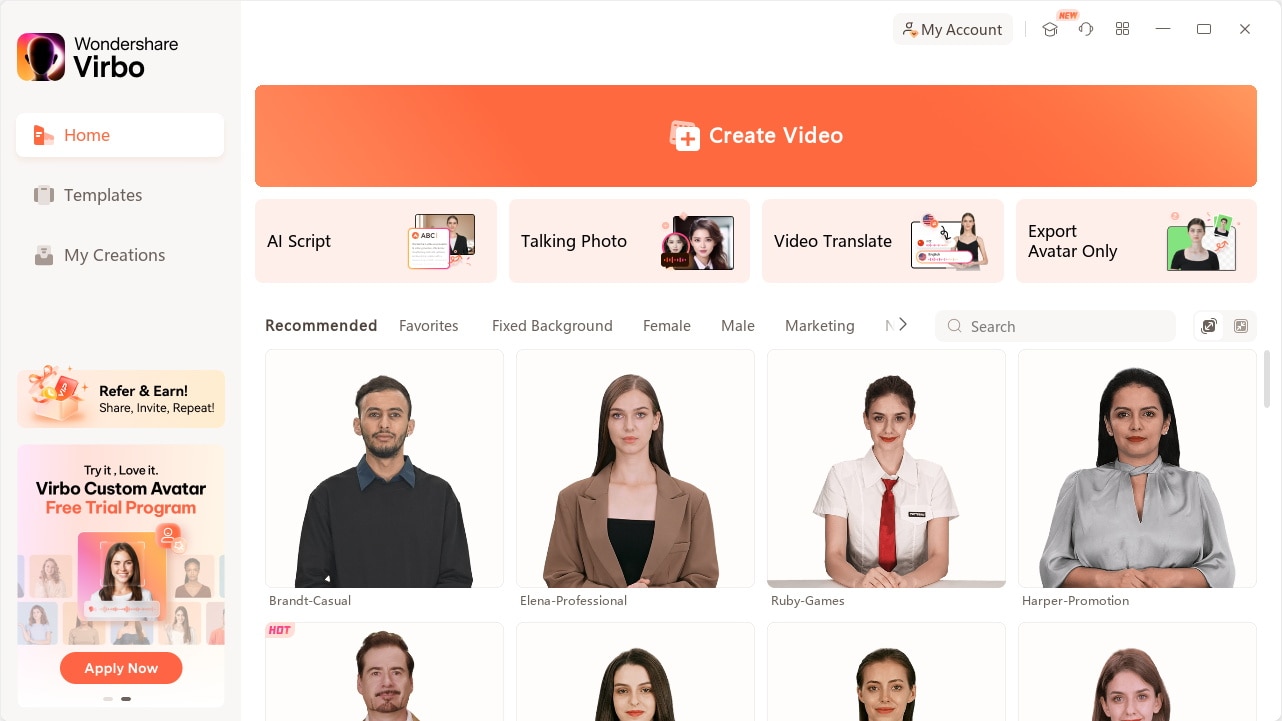
Click Talking Photo
Pick a template or click “Upload Picture” to upload your own picture and tap “Next”.
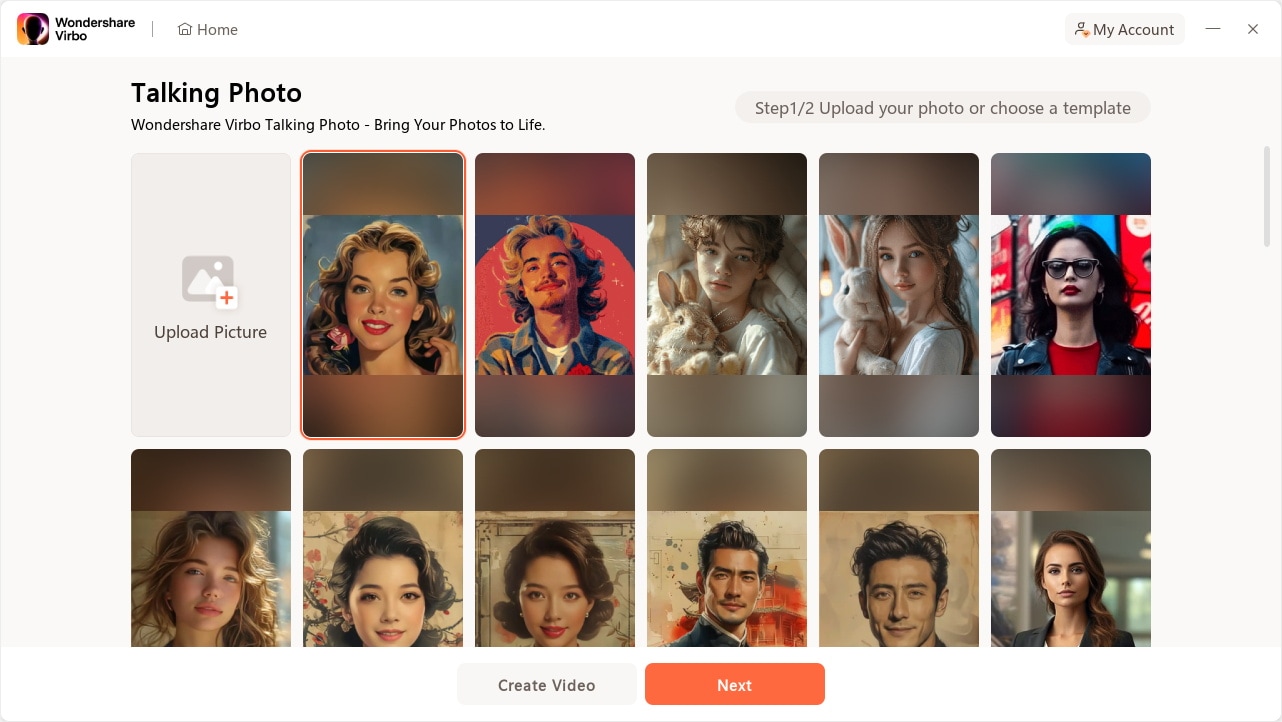
Create Next Button
Step 2. Input Text and Set A Voiceover
Enter your voiceover script or click the ‘Audio Upload’ to import an audio file as the voiceover.
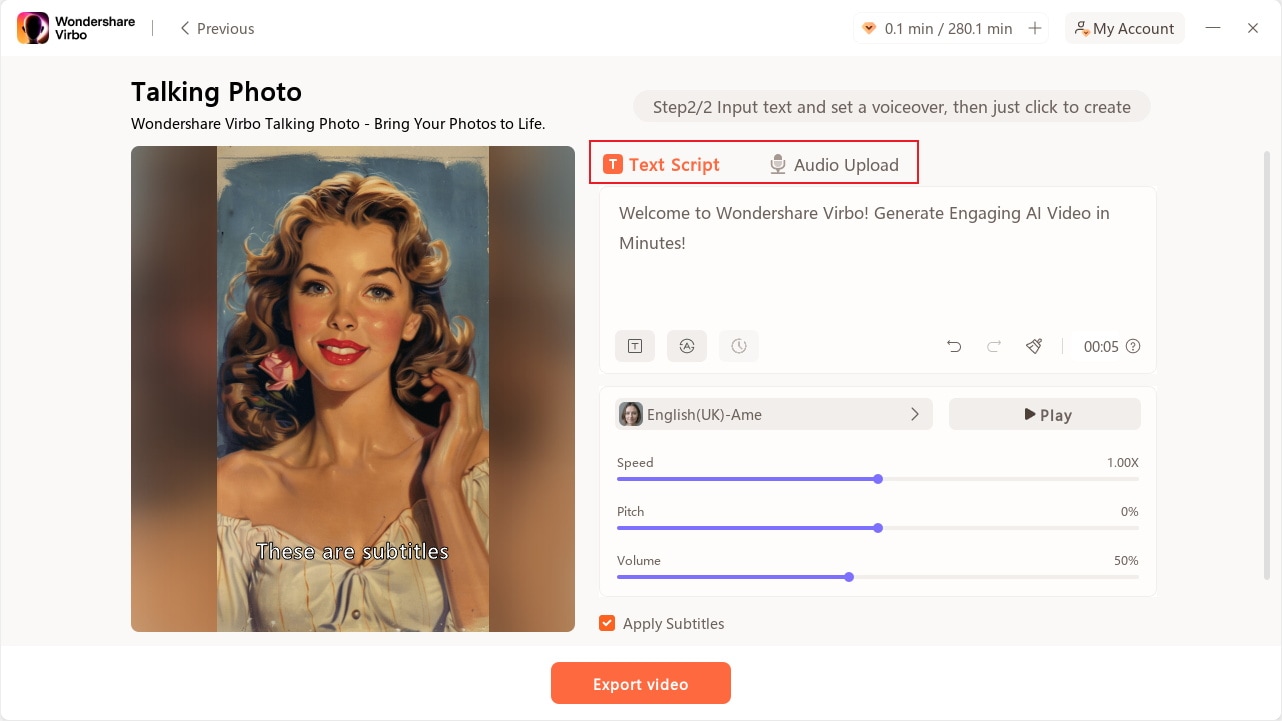
Input Script
After entering your voiceover script, you can customize the language, and adjust playback speed, pitch, and volume.
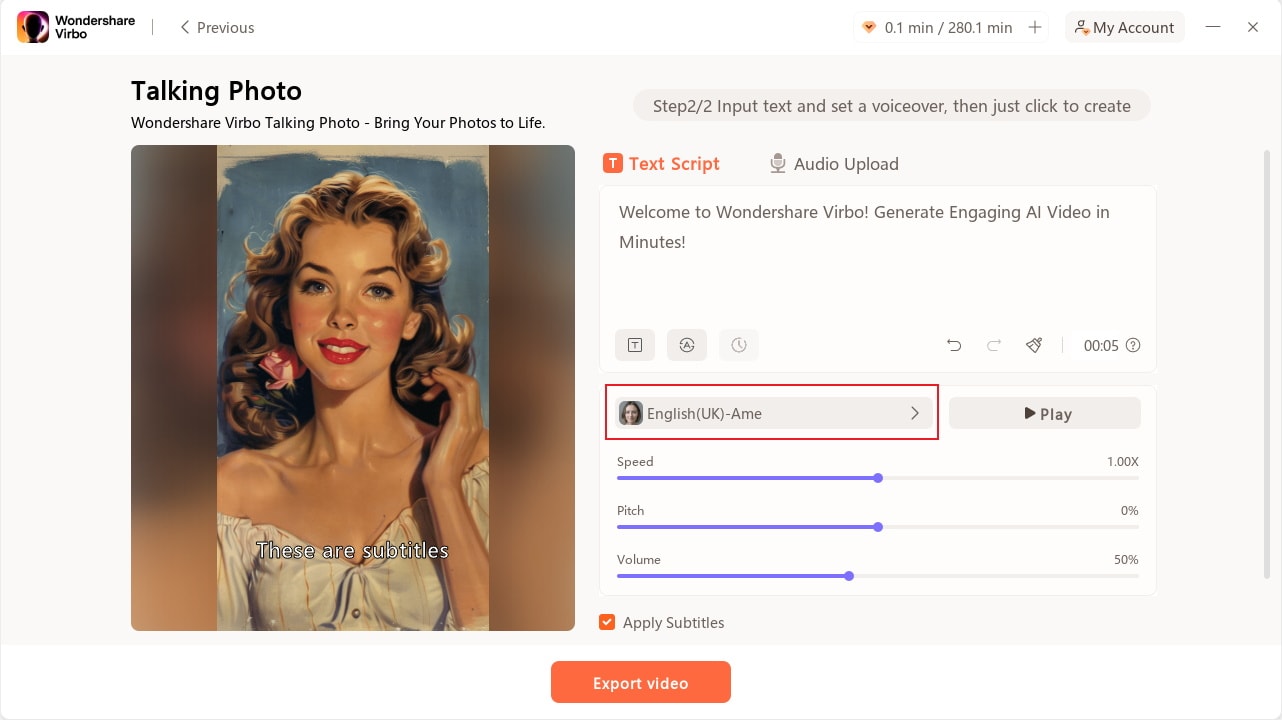
Edit Voiceover
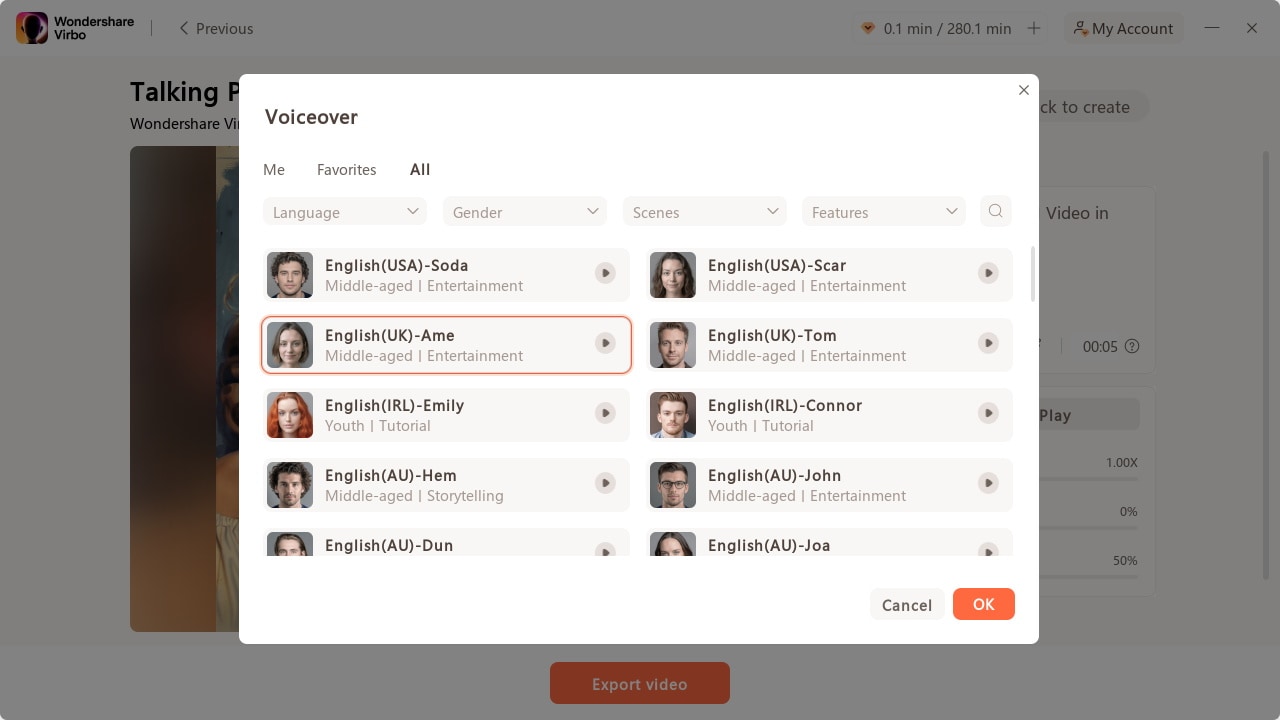
Choose Voiceover
Check “Background Music” to add or upload background music, or add subtitles by checking “Apply Subtitles”.
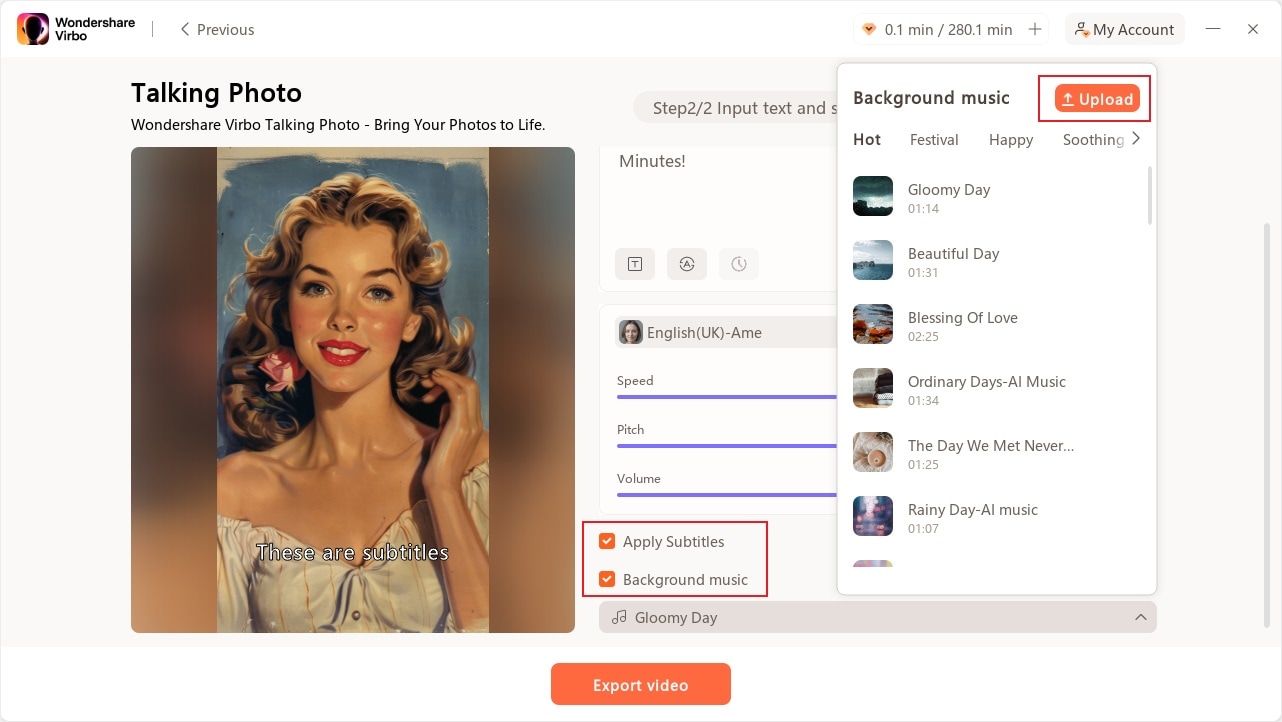
Apply Subtitles And Add Background Music
Step 3. Export Talking Photo
Now, you can click “Export Video” to export the talking photo. Wait for export successfully and then you will see it under “My Creations”.
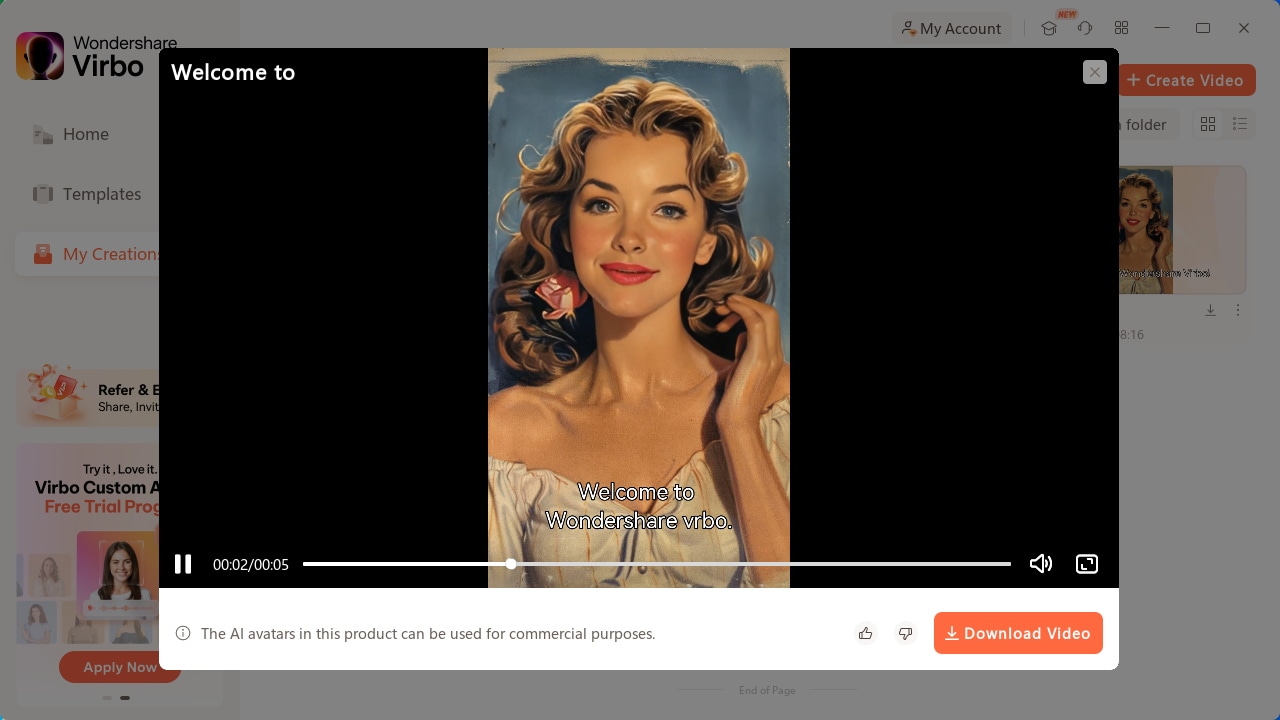
Download Talking Photo
Make Photos Speak Make Photos Speak
Way 2: Use Your Still Photos to Create Videos
Want to create videos with your photo? You can view the following steps:
Step 1. Create a project
After clicking “Talking Photo” on the homepage, pick an image you desire or click “+” to upload an image and tap “Create Video” to start creating a new video.
Generate AI Video Free Generate AI Video Free

Create Video
Step 2. Edit video
Type/paste your voiceover script or click “Audio Upload” to upload/extract/record the audio as video script. You can choose different languages and adjust speed, pitch, and volume at the operation bar. You can also switch the background, add background music, or add subtitles.

Edit Video
Step 3. Export video
Click preview to check the effect of your video. Once you are satisfied with the whole video, click “Export” to generate the video.
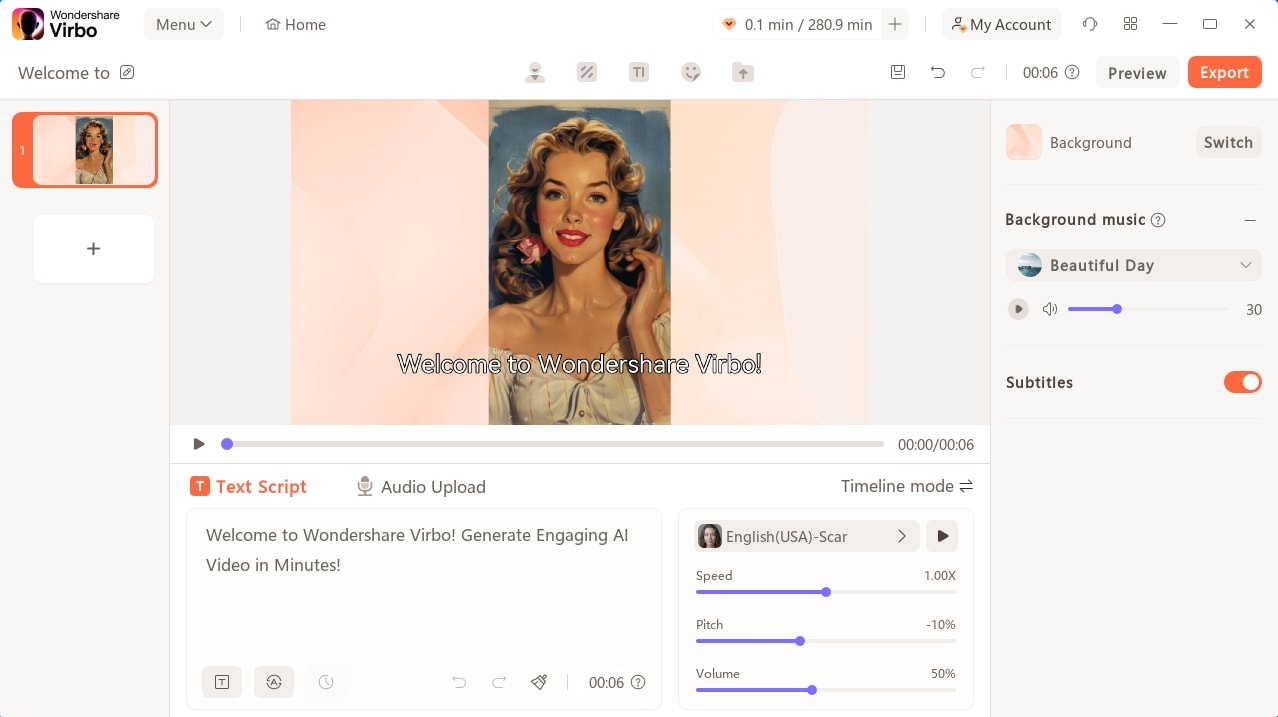
Export Video
The generated video will be shown on “My Creations”. You can view it and click “Download Video” to save it to your computer.
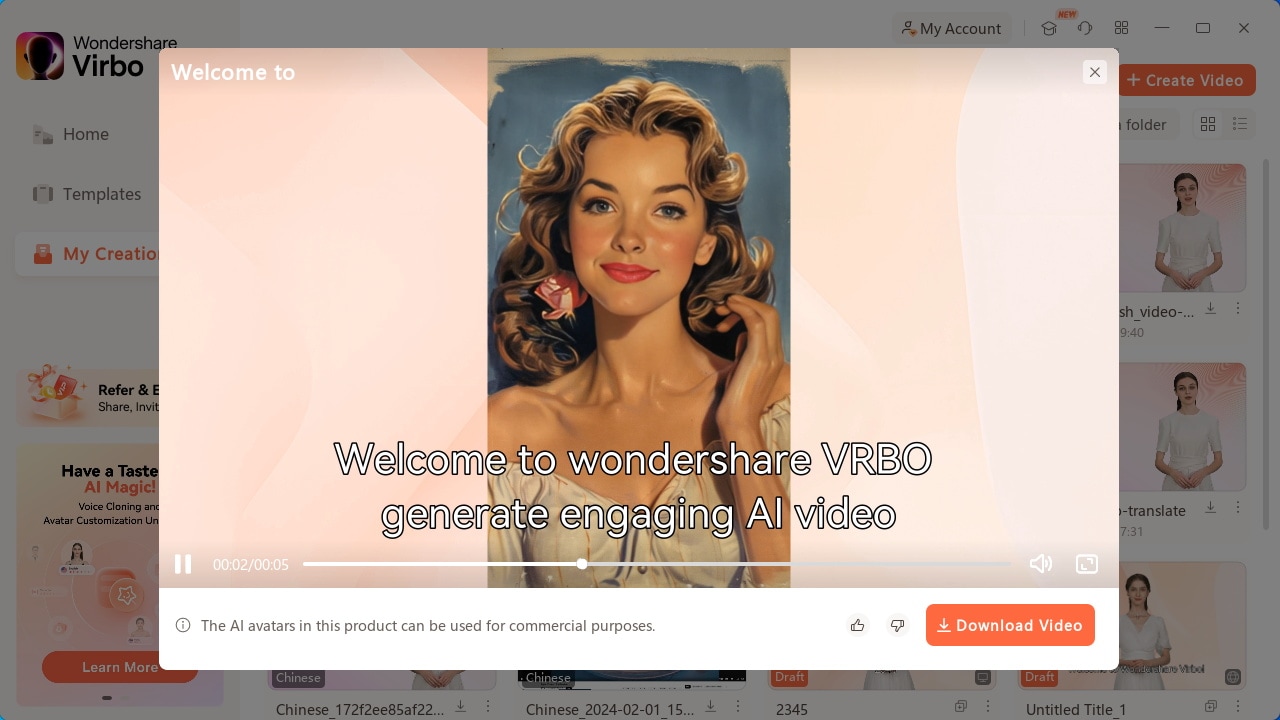
Download Video
Generate AI Video Free Generate AI Video Free
02Use Your Still Photos to Create Videos
Way 1: Simply Bring Your Photos to Life with 2 Steps
Simply input your script (or use Virbo’s AI feature to generate one), choose the voice-over, and export the video to achieve the desired effect! You can also record audio online or upload your own recordings to make your photos speak.
Step 1. Choose Talking Photo
Download and install Wondershare Virbo on your computer and click “Talking Photo” to bring photos to life.
Make Photos Speak Make Photos Speak

Click Talking Photo
Pick a template or click “Upload Picture” to upload your own picture and tap “Next”.

Create Next Button
Step 2. Input Text and Set A Voiceover
Enter your voiceover script or click the ‘Audio Upload’ to import an audio file as the voiceover.

Input Script
After entering your voiceover script, you can customize the language, and adjust playback speed, pitch, and volume.

Edit Voiceover

Choose Voiceover
Check “Background Music” to add or upload background music, or add subtitles by checking “Apply Subtitles”.

Apply Subtitles And Add Background Music
Step 3. Export Talking Photo
Now, you can click “Export Video” to export the talking photo. Wait for export successfully and then you will see it under “My Creations”.

Download Talking Photo
Make Photos Speak Make Photos Speak
Way 2: Use Your Still Photos to Create Videos
Want to create videos with your photo? You can view the following steps:
Step 1. Create a project
After clicking “Talking Photo” on the homepage, pick an image you desire or click “+” to upload an image and tap “Create Video” to start creating a new video.
Generate AI Video Free Generate AI Video Free

Create Video
Step 2. Edit video
Type/paste your voiceover script or click “Audio Upload” to upload/extract/record the audio as video script. You can choose different languages and adjust speed, pitch, and volume at the operation bar. You can also switch the background, add background music, or add subtitles.

Edit Video
Step 3. Export video
Click preview to check the effect of your video. Once you are satisfied with the whole video, click “Export” to generate the video.

Export Video
The generated video will be shown on “My Creations”. You can view it and click “Download Video” to save it to your computer.

Download Video
Generate AI Video Free Generate AI Video Free
Create Videos with an AI Script Generator
Create videos with an AI script generator
You can complete your video creation using Virbo’s AI Script Generator tool. The specific steps are as follows:
01 Generate your script with AI
Step 1: Add the keywords and basic information for the script you want to prepare. Proceed to the “Key selling points” section for important information in the video.
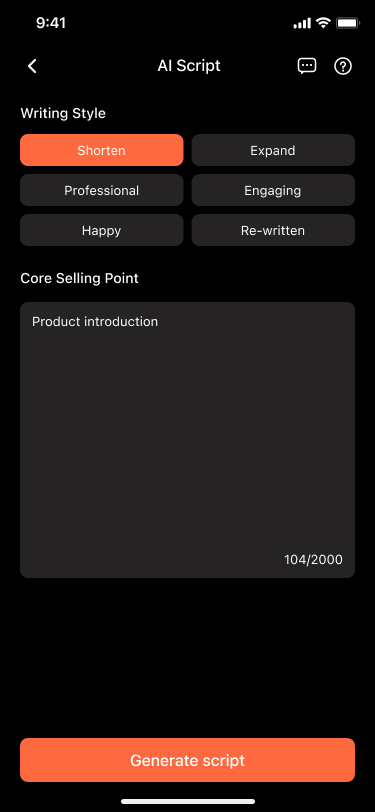
Step 2: After providing all information, select the “Generate script” button on the bottom to start the process.

Step 3: It takes time to complete, but once finished, the script will be displayed on the next screen. You can make specific edits to the script as desired. Then, proceed to select the “Create video” button to generate an AI video based on the script.
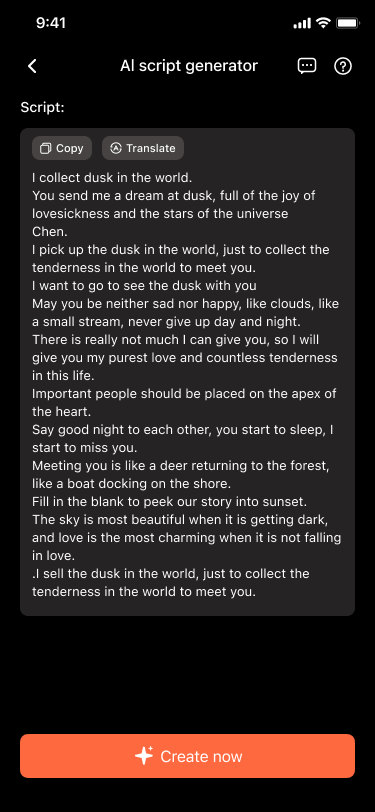
02 Create AI videos based on the script
Step 1: Upon clicking the “Create video” button, you will be directed to the AI video creation screen, where you can choose your preferred avatar.
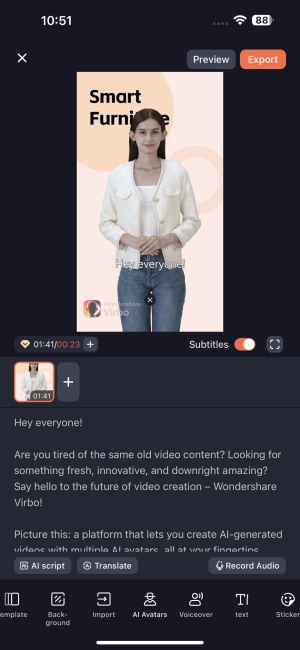
Step 2: At the same time, you can customize the template style, video background, voiceover , and text style. Additionally, you can add stickers and music. If you are satisfied with the result, you can proceed to export the final video.
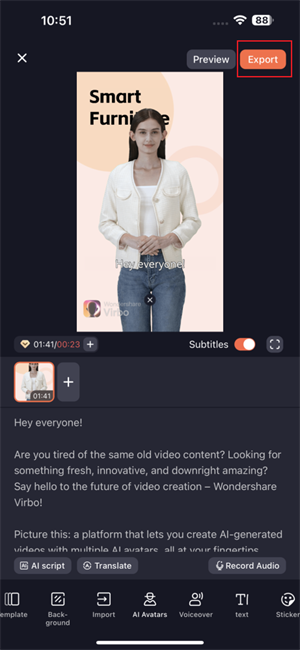
Note
Please note that free users are limited to exporting videos of up to 30 seconds in duration. Should you exceed this limit, upgrading to the premium version is required to export longer videos.
01 Generate your script with AI
Step 1: Add the keywords and basic information for the script you want to prepare. Proceed to the “Key selling points” section for important information in the video.

Step 2: After providing all information, select the “Generate script” button on the bottom to start the process.

Step 3: It takes time to complete, but once finished, the script will be displayed on the next screen. You can make specific edits to the script as desired. Then, proceed to select the “Create video” button to generate an AI video based on the script.

02 Create AI videos based on the script
Step 1: Upon clicking the “Create video” button, you will be directed to the AI video creation screen, where you can choose your preferred avatar.

Step 2: At the same time, you can customize the template style, video background, voiceover , and text style. Additionally, you can add stickers and music. If you are satisfied with the result, you can proceed to export the final video.

Note
Please note that free users are limited to exporting videos of up to 30 seconds in duration. Should you exceed this limit, upgrading to the premium version is required to export longer videos.
Exploring the Magic of AI Selfie Generators
Part 1. What is an AI Selfie Generator?
An AI Selfie Generator is a groundbreaking tool that employs advanced AI algorithms, often based on deep learning and neural networks, to create realistic and artistic selfies. These generators analyze facial features, expressions, and patterns from a vast dataset of human faces, resulting in stunning self-portraits that resonate with authenticity.
Part 2. Benefits of AI Selfie Generators
Expressive Versatility
AI Selfie Generators offer a range of styles and filters that allow users to transform their selfies into various artistic renditions, enhancing personal expression.
Effortless Enhancement
Say goodbye to complex editing tools. AI Selfie Generators effortlessly enhance selfies, ensuring optimal lighting, skin tone correction, and other refinements.
Time-Saving Creativity
Generating captivating selfies is quick and efficient, sparing users from spending hours on manual editing.
Part 3. Common Scenarios for AI Selfie Generators
Social Media Engagement
AI-generated selfies can grab attention on social media platforms, boosting user engagement and interaction.
Creative Exploration
Artists and designers use AI Selfie Generators to experiment with unique visual styles, leading to captivating artworks.
Personal Branding
Influencers and content creators can establish a consistent and striking visual identity by utilizing AI-generated selfies.
Part 4. Free AI Selfie Generator - Wondershare Virbo
Experience the wonder of Wondershare Virbo - an AI Selfie Generator that stands out for its user-friendly interface and diverse creative asserts. Virbo’s avatar studio empowers users to transform their selfies into stunning visuals with just a few clicks, enhancing facial features, correcting imperfections, and adding artistic flair.
Conclusion
The era of AI Selfie Generators has arrived, redefining how we capture and present our digital selves. With their ability to effortlessly enhance and transform selfies, these tools are changing the way we express ourselves online. As you journey through this realm of AI-powered creativity, remember that the power to create captivating, authentic, and artistic selfies is now at your fingertips.
Part 1. What is an AI Selfie Generator?
An AI Selfie Generator is a groundbreaking tool that employs advanced AI algorithms, often based on deep learning and neural networks, to create realistic and artistic selfies. These generators analyze facial features, expressions, and patterns from a vast dataset of human faces, resulting in stunning self-portraits that resonate with authenticity.
Part 2. Benefits of AI Selfie Generators
Expressive Versatility
AI Selfie Generators offer a range of styles and filters that allow users to transform their selfies into various artistic renditions, enhancing personal expression.
Effortless Enhancement
Say goodbye to complex editing tools. AI Selfie Generators effortlessly enhance selfies, ensuring optimal lighting, skin tone correction, and other refinements.
Time-Saving Creativity
Generating captivating selfies is quick and efficient, sparing users from spending hours on manual editing.
Part 3. Common Scenarios for AI Selfie Generators
Social Media Engagement
AI-generated selfies can grab attention on social media platforms, boosting user engagement and interaction.
Creative Exploration
Artists and designers use AI Selfie Generators to experiment with unique visual styles, leading to captivating artworks.
Personal Branding
Influencers and content creators can establish a consistent and striking visual identity by utilizing AI-generated selfies.
Part 4. Free AI Selfie Generator - Wondershare Virbo
Experience the wonder of Wondershare Virbo - an AI Selfie Generator that stands out for its user-friendly interface and diverse creative asserts. Virbo’s avatar studio empowers users to transform their selfies into stunning visuals with just a few clicks, enhancing facial features, correcting imperfections, and adding artistic flair.
Conclusion
The era of AI Selfie Generators has arrived, redefining how we capture and present our digital selves. With their ability to effortlessly enhance and transform selfies, these tools are changing the way we express ourselves online. As you journey through this realm of AI-powered creativity, remember that the power to create captivating, authentic, and artistic selfies is now at your fingertips.
What Is an AI Editor?
Part 1. What’s the definition of an AI editor?
AI Editor refers to an editing tool or software developed based on artificial intelligence technology. It assists individuals in text editing, writing, proofreading, and revision tasks using natural language processing, machine learning, and other AI techniques.
AI Editors are comprehensive in scope and can have various functionalities, such as:
01of 05 Automated proofreading and correction
AI Editors can automatically detect and correct spelling errors, grammar mistakes, and punctuation errors in text, improving accuracy and fluency.
02of 05 Intelligent suggestions and completion
AI Editors can analyze the context of the text and provide intelligent suggestions and completions to help users improve sentence structure, word choice, and expression.
03of 05 Style and tone adjustment
AI Editors can adjust the style and tone of the text according to user needs, such as converting it to formal language, colloquial language, or other specific types.
04of 05 Content optimization
AI Editors can analyze the logical structure and coherence of the text and provide optimization suggestions to make the writing more logical and clearer.
05of 05 Language translation
Some AI Editors also have translation capabilities, automatically translating the text into other languages and providing cross-language editing and writing support.
AI Editors aims to provide efficient, accurate, and intelligent editing assistance, helping users enhance the quality and efficiency of their writing. However, AI editing technology is still in development, and there may be certain limitations, requiring users to perform further proofreading and corrections.
Part 2. Specific extension types of AI editors
Because AI editor is a collective concept, the AI sub-products derived from it are the applications that have more practical value. Here are some common AI editors and their advantages compared to their traditional counterparts.
1. AI Text Editor
This is the most common type of AI Editor, used for assisting with proofreading, editing, improving, and generating text. It automatically detects spelling and grammar issues and provides semantic suggestions and improvements.
2. AI Photo Editor
This type of AI Editor focuses on image processing and editing. It can apply various image filters, adjust brightness, contrast, and saturation parameters, and even automatically fix image defects and enhance image quality.
3. AI Audio Editor
This type of AI Editor is used for processing audio files, including editing, mixing, noise reduction, and audio enhancement. It can automatically identify and remove noise and provide audio restoration and enhancement effects.
4. AI Video Editor
This type of AI Editor is used for editing and processing video content. It can perform video clipping, cutting, merging, apply video effects and transition effects, and even automate video editing and theme generation.
5. AI Code Editor
This type of AI Editor aims to assist developers in writing and modifying code. It can provide features such as automatic code completion, syntax checking, error fixing, and refactoring suggestions, improving code quality and development efficiency.
In addition to the above types, various other specific domain-specific AI Editors, such as AI Legal Editor, AI Medical Editor, etc., focus on editing and improving text or content in specific domains. These AI Editor extension types aim to leverage artificial intelligence technology to provide more efficient, accurate, and intelligent editing and processing capabilities to meet the needs of different domains and tasks.
Part 3. What advantages do AI editors have compared to traditional editors?
Compared to traditional ones, AI editors have several advantages:
1. Efficiency
AI Editors can significantly improve efficiency by automating tasks that would otherwise require manual effort. They can quickly detect errors, suggest improvements, and provide automated solutions, reducing the time and effort required for editing and processing.
2. Accuracy
AI Editors leverage advanced algorithms and machine learning techniques to offer high levels of accuracy. They can detect subtle errors, inconsistencies, and provide precise suggestions for improvement, resulting in more polished and error-free content.
3. Intelligent Assistance
AI Editors provide intelligent assistance by analyzing the context and semantics of the content. They can offer context-aware suggestions, identify potential issues, and propose alternative phrasings or word choices, enhancing the overall quality of the text.
4. Accessibility
AI Editors are accessible and available anytime and anywhere. They can be accessed through web-based platforms or integrated into various software applications, making them easily accessible to users regardless of their location or device.
5. Continuous Learning
AI Editors can continuously learn from user interactions and feedback, improving their capabilities over time. They can adapt to user preferences, learn specific writing styles, and enhance their suggestions and recommendations based on user preferences and patterns.
6. Specialized Features
Some AI Editors offer specialized features tailored to specific domains. For example, AI Code Editors can provide code-specific suggestions and automate repetitive coding tasks, while AI Photo Editors can offer advanced image enhancement algorithms. These specialized features provide added value and convenience for users in their respective domains.
Overall, AI Editors offer increased speed, accuracy, intelligent assistance, and specialized features, making them powerful tools for content editing and processing compared to traditional products.
Part 1. What’s the definition of an AI editor?
AI Editor refers to an editing tool or software developed based on artificial intelligence technology. It assists individuals in text editing, writing, proofreading, and revision tasks using natural language processing, machine learning, and other AI techniques.
AI Editors are comprehensive in scope and can have various functionalities, such as:
01of 05 Automated proofreading and correction
AI Editors can automatically detect and correct spelling errors, grammar mistakes, and punctuation errors in text, improving accuracy and fluency.
02of 05 Intelligent suggestions and completion
AI Editors can analyze the context of the text and provide intelligent suggestions and completions to help users improve sentence structure, word choice, and expression.
03of 05 Style and tone adjustment
AI Editors can adjust the style and tone of the text according to user needs, such as converting it to formal language, colloquial language, or other specific types.
04of 05 Content optimization
AI Editors can analyze the logical structure and coherence of the text and provide optimization suggestions to make the writing more logical and clearer.
05of 05 Language translation
Some AI Editors also have translation capabilities, automatically translating the text into other languages and providing cross-language editing and writing support.
AI Editors aims to provide efficient, accurate, and intelligent editing assistance, helping users enhance the quality and efficiency of their writing. However, AI editing technology is still in development, and there may be certain limitations, requiring users to perform further proofreading and corrections.
Part 2. Specific extension types of AI editors
Because AI editor is a collective concept, the AI sub-products derived from it are the applications that have more practical value. Here are some common AI editors and their advantages compared to their traditional counterparts.
1. AI Text Editor
This is the most common type of AI Editor, used for assisting with proofreading, editing, improving, and generating text. It automatically detects spelling and grammar issues and provides semantic suggestions and improvements.
2. AI Photo Editor
This type of AI Editor focuses on image processing and editing. It can apply various image filters, adjust brightness, contrast, and saturation parameters, and even automatically fix image defects and enhance image quality.
3. AI Audio Editor
This type of AI Editor is used for processing audio files, including editing, mixing, noise reduction, and audio enhancement. It can automatically identify and remove noise and provide audio restoration and enhancement effects.
4. AI Video Editor
This type of AI Editor is used for editing and processing video content. It can perform video clipping, cutting, merging, apply video effects and transition effects, and even automate video editing and theme generation.
5. AI Code Editor
This type of AI Editor aims to assist developers in writing and modifying code. It can provide features such as automatic code completion, syntax checking, error fixing, and refactoring suggestions, improving code quality and development efficiency.
In addition to the above types, various other specific domain-specific AI Editors, such as AI Legal Editor, AI Medical Editor, etc., focus on editing and improving text or content in specific domains. These AI Editor extension types aim to leverage artificial intelligence technology to provide more efficient, accurate, and intelligent editing and processing capabilities to meet the needs of different domains and tasks.
Part 3. What advantages do AI editors have compared to traditional editors?
Compared to traditional ones, AI editors have several advantages:
1. Efficiency
AI Editors can significantly improve efficiency by automating tasks that would otherwise require manual effort. They can quickly detect errors, suggest improvements, and provide automated solutions, reducing the time and effort required for editing and processing.
2. Accuracy
AI Editors leverage advanced algorithms and machine learning techniques to offer high levels of accuracy. They can detect subtle errors, inconsistencies, and provide precise suggestions for improvement, resulting in more polished and error-free content.
3. Intelligent Assistance
AI Editors provide intelligent assistance by analyzing the context and semantics of the content. They can offer context-aware suggestions, identify potential issues, and propose alternative phrasings or word choices, enhancing the overall quality of the text.
4. Accessibility
AI Editors are accessible and available anytime and anywhere. They can be accessed through web-based platforms or integrated into various software applications, making them easily accessible to users regardless of their location or device.
5. Continuous Learning
AI Editors can continuously learn from user interactions and feedback, improving their capabilities over time. They can adapt to user preferences, learn specific writing styles, and enhance their suggestions and recommendations based on user preferences and patterns.
6. Specialized Features
Some AI Editors offer specialized features tailored to specific domains. For example, AI Code Editors can provide code-specific suggestions and automate repetitive coding tasks, while AI Photo Editors can offer advanced image enhancement algorithms. These specialized features provide added value and convenience for users in their respective domains.
Overall, AI Editors offer increased speed, accuracy, intelligent assistance, and specialized features, making them powerful tools for content editing and processing compared to traditional products.
Easy Tutorial How To Make a Talking Cartoon Video [Step-by-Step]
Making animated characters talk can make your videos even more interesting and appealing to your audience. It brings your characters to life by giving them personality and emotion through speech. They can engage in dialogue, convey complex emotions, and drive the narrative forward.
Creating a talking animation is possible with the help of AI and the right tool we have covered in this article. These talking animated characters are not only for entertainment. Educational content, tutorials, and presentations can benefit significantly from this approach, as it enhances the clarity and engagement of the information you want to convey.
If you are ready to learnhow to make animation talk , let’s jump right in.
Part 1. How To Create Simple Animation From a Template
Have you already prepared the animation before we get intohow to make talking animation ? If not, that’s okay. Making a basic and simple animation can be done by using a template on platforms like Animaker. This method is especially great if you’re not familiar with making video animations and want an easy way to create one.
How to create a simple animated character:
Step 1: Sign up or log in to your account.
If you haven’t signed up on Animaker yet, you can register here. Then, sign in with your account.
Step 2: Select an animation template.
After logging in, the dashboard will be your landing page. This page will feature an array of pre-designed templates across various categories. Find a template that caught your attention and click “Use.”

Step 3: Editing the animated character
Since the template comes with a pre-existing character, you can either use it as-is or modify it according to your requirements. If you want to edit the animated character, you can click on the character to open the Actions Tab.

Browse through the available actions to change the character’s movements or use the search function to find specific actions. Additionally, you can also explore the Expressions tab to modify the character’s facial expressions, skin tone, hair color, eye color, and attire.
For further visual guidance, you can also refer to their video tutorials. Once you’ve completed your animated character, let’s proceed tohow to make animation talk .
Part 2. How To Make The Animation Talks
Now, we are moving tohow to make animated characters talk . But before diving in, make sure you have your necessary script or audio recording ready. Then, follow these steps onhow to create a talking animation.
Step 1: Open the item menu.
To add voiceovers to your characters, click on your animated character. This action will open an additional menu and show you a range of options. Then, select Lip-sync.

Step 2: Add voice to your animated characters.
After selecting Lip-sync, you’ll have the choice to either record your own voice, utilize a text-to-speech tool for automated speech, or upload a pre-recorded voiceover to synchronize with your character. If you opt for text-to-speech, input the dialogue and select parameters such as gender, language, and voice.

When tryinghow to create talking animation , features like Auto-enhance can also refine the voiceover for a more human-like quality.
Step 3: Download the talking animated character video.
With the voice added to your animated character, it’s time to preview the video to ensure everything is in order. To do so, click the play button to initiate the preview. Once satisfied, proceed to download the video by clicking “Publish” > “Download Video” and then “Download” to obtain your talking animated character video.

Part 3. Best Direct Way: How to Make Anime Character Talks from A Photo
Is there an easier methodhow to make animation talk ? If you find the process of animating challenging, an alternative and simpler way can be using a talking avatar from a photo.Wondershare Virbo offers an easy solution for this purpose. Virbo is a versatile video production tool that utilizes AIGC technology to create talking avatars.
Wondershare Virbo’s Talking Photos feature provides the flexibility to choose from existing AI anime avatar templates or upload anime pictures. This animated character can then be animated to talk according to the script or narration you’ve prepared.
Some of Virbo Talking Avatar features include:
- Access a diverse library of over 300 royalty-free AI avatars
- Break down language barriers with a selection of over 300 AI voices
- Equipped with easy tutorials
- Seamless cross-platform experience on online, desktop, and mobile application
- Incorporate subtitles for enhanced accessibility
Get Started Online Free Download
How to make a talking cartoon video with ease:
Step 1: Install Wondershare Virbo on your computer.
First, download Wondershare Virbo and follow the instructions for installation. After launching the software, locate and click “Talking Photo” within the interface.

Step 2: Upload an anime character photo or choose an anime AI avatar
Click on the upload icon (+) and select the anime or cartoon character image. You can adjust and crop the picture according to your preferences. Afterward, click on “Create Video” to proceed.
Note: There are certain criteria for selecting cartoon character images to make a talking cartoon video. We will discuss it in the following section.

Step 3: Add voice to your anime or cartoon character.
After selecting the talking avatar, you can input your text and choose a voiceover option from the provided selection. Adjust parameters such as accent, speed, pitch, and volume to your liking. While it’s optional, you can also choose to include subtitles and background music, and even change the background.

For those preferring to use their own voice, select either “Audio Upload” to upload existing audio files or “Online Recording” to record directly within the software. If your audio is embedded within a video file, choose “Extract audio” and Virbo will extract the audio accordingly.

Step 4: Export the talking avatar
Once you’ve finished editing your video, click “Export” to export your creation. Allow a few minutes for processing, and your talking avatar videos will be ready for download.
Note: Wondershare Virbo for desktops currently offers the best conversion effect. But if you prefer tocreate talking animation online , you can also use Wondershare Virbo online through their website. You can also watch this video onhow to make animation talk .
Get Started Online Free Download
Bonus: What Kind of Anime Pictures Are Suitable to Make Talking Animation
As we have mentioned before, you can also upload anime photos in Wondershare Virbo and make the animated character talk. However, you need to note that these photos must meet specific criteria to ensure optimal results in your animations before trying onhow to make animation talk .
Some anime picture specifications you can use to make a talking cartoon video:
- Having clear features
Opt for anime pictures with well-defined and easily recognizable features to achieve more accurate results. Wondershare Virbo usually won’t detect anime pictures with simple lines or undefined lines.
- Free of copyright infringement
It’s essential to use images that are free from any copyright restrictions or infringement. Only use anime character photos that you have the legal right to use, whether they are from your personal collection or obtained from royalty-free sources.
- Proper lighting and resolution
Images with proper lighting and high resolution are essential for achieving crisp and detailed animations. Avoid images that are overly dark, blurry, or pixelated, as they may result in less visually appealing animations.
- Facing forward with a clear and visible face
Select images where the anime character is facing forward and their face is clearly visible. This allows for precise facial animation, including lip-syncing and expression changes, which are key elements in creating realistic talking animations.

Conclusion
How to create talking animation involves a multi-step process to bring life and personality to your animation. It involves synchronizing the movements of a character’s lips and facial expressions with the spoken words to create the illusion of speech.
The step-by-step guide provided in this article offers two approaches onhow to create talking animation . You can create simple animations using templates on platforms like Animaker and employ AI technology with tools like Wondershare Virbo to make characters talk easily from a photo.
Easy Guide: How To Make Talking Head Videos
Photos and videos always add more power to your marketing campaigns. From presentations to promotional videos, every visual helps to captivate the audience. So, why not make them more creative to generate maximum leads? This article presents an AI-powered tool that allows the creation oftalking head videos for different purposes. Using anAI talking head video can assist in delivering your message with fun.
Moreover, you can also learn tips to make your interactive videos even more professional. Other than that, a dedicated section unveils some major types of talking head videos.

Part 1. Getting To Know the Major Types of Talking Head Videos
Atalking head video features a person talking directly in front of a camera. It can also include the shoulders or even the entire body of the speaker. You can generate these AI talking head videos by animating your pictures for more engagement. This type of video is mainly intended for tutorials, interviews, product reviews, and training. Most importantly, they help to improve your interactions with viewers.
Now, it’s time to explore the major types of talking head videos that serve different purposes. Let’s explore them one by one and learn how they are beneficial for you.
1. Explainer Talking Head Videos
Anexplainer video is the most commontalking head video example . These videos are made to explain concepts or topics related to different subjects. Content creators use this type of video to make connections with their audiences. Moreover, some businesses use explainer videos on their landing pages for marketing purposes.

2. Business Talking Head Videos
Employees and shareholders can communicate throughAI talking head videos in a corporation. They can also interact with customers to provide them with a personalized experience. Also, this type of video increases the engagement rate to grow your business.

3. Interview Talking Head Videos
Using a talking head video strategy is helpful for interviews. In these videos, the speaker usually captures the face and some parts of the body while talking to the camera. Therefore, both sides can remain focused on what they are discussing. Moreover, one-to-one interactions help to understand the personality and skills in a better manner.

4. Product Review Talking Head Videos
Customers or content creators make product review videos to share their opinions about products or services. Thisexample of a talking head video helps demonstrate a product to the audience with different perspectives. Business owners can create engaging videos to assist their viewers in understanding their products and services.

Part 2. Create Perfect Talking Head Videos for Impressive Results Using Wondershare Virbo
If you have a query abouthow to create talking head videos , this section provides the best solution. Here, we will introduce you to the best AI talking video creator,Wondershare Virbo . It provides an AI Talking Photo feature to make dull pictures come alive. Also, this tool facilitates both online and offline users to create content for marketing and other purposes.
There is a whole variety of AI avatars with different outfits and poses. You can choose your favorite avatar or picture to engage with the audience. Moreover, you can add text to convert it into a speech for your talking video. This tool even allows you to upload voice clips and customize them according to your needs.
Prominent Features of Wondershare Virbo
- AI Talking Photo feature allows you to add background music to your talking head videos for a personalized experience.
- Users can make creative talking heads videos in offline mode. Therefore, you can download the tool and use it without the internet.
- It has anAI script feature that can optimize the content of yourAI talking head video .
Comprehensive Guide to Creating Talking Photo Videos Using Wondershare Virbo
You can generate dozens of videos within no time through Wondershare Virbo. Its AI features provide a next-level experience for crafting videos, which is explained as follows:
Step 1. Launch the Tool and Move To Create a Video
Download the Wondershare Virbo tool and launch it to access the functionality. Select the “Talking Photo” feature on the main interface to create a new project. After this, a pop-up screen with a wide range of avatars will appear.

Get Started Online Free Download
Step 2. Import a Photo To Generate a Talking Head Video
Upon accessing the pop-up screen, hit the “Import Photo” icon to add your headshot to this tool. Once you import the picture, click the “Create Video” button to create your video.

Step 3. Add Text To Make Your Photo Talk
After that, select the “Text Script” option to type or paste the text. This text turns into a speech for your talking photo. You can also click on the “AI Script” feature to add text and try the smart optimizations that are given on the right side of the window.

Step 4. Choose the Desired Language and Accent
You can click on the languages menu to access a new pop-up window. In this window, you can choose the required language and accent. Next, click “Gender” from the drop-down you want to use for the voiceover. After selecting these options, hit the “OK” button to proceed.

Step 5. Adjust the Voiceover Features
Once you have selected the language and gender, it is time to adjust the voiceover properties. Drag the “Volume” bar to increase or decrease the volume. You can also change the pitch by adjusting the “Pitch” bar.

Step 6. Export Your Talking Head Video
After making all the selections, you are ready to take your masterpiece out. For that, you can select the “Export” option. Then, you can also adjust the resolution for the final output. Afterward, it takes you to the “My Creations” window to check yourAI talking head video .

Part 3. Where Can a Talking Head Video Be Put To Use?
In the current digital market, animated and whiteboard videos have their worth. However, talking head videos have emerged as the new way to market products. They offer more authenticity and credibility while building connections for your company. Also, these videos help emotionally attach the presenter and the viewer.
As discussed before, you can make explainer videos to deliver your thoughts about a subject or concept. The corporate videos keep employees, customers, and stakeholders attached. Moreover, users can create product review videos to help others understand products or reviews better. Overall,talking head videos are fruitful for marketing, engagement, lead generation, and more.
Tips To Make Professional Talking Head Videos
Learning the right strategy for making talking head videos is essential. A high-quality video helps to deliver a message precisely without distraction. Here are some authentic tips that help you understandhow to make talking head videos more interesting and professional:
1. Plan the Script for Your Video
Going anywhere without preparation is always a disaster; the same goes for creating videos. You should make a rough outline with a concise subject. The video’s intent should be clear so you can deliver it to the right audience. Also, pre-planning can help to craft a professional script and shoot videos accordingly.
2. Adjust Lighting for a Better View
Lighting plays a pivotal role in shooting videos. So, you should focus on lighting adjustments and clarity. Also, you need to avoid overexposure, harsh shadows, and lousy lighting resources. You can also use natural light that doesn’t throw shadows.
3. Improve Audio Quality
Undoubtedly, audio is half of your content and delivers your message to the audience. Therefore, low audio quality is unacceptable when creating professionaltalking head videos. Using a camera microphone might not be a good choice as it doesn’t provide high quality. Therefore, you can use a lapel or boom mic to enhance voice quality.
4. Make Your Setup Decent
You can work on your setup to make your videos more professional and exciting. Your environment reflects a picture of the viewers’ minds. Making your setup look better is a good strategy for engagement. For this purpose, you can use some visually appealing props in your room.
5. Use Two Cameras or More
You can try shooting videos from different angles with more than one camera. This dynamic video looks interesting to viewers, so they can boost engagement. With this advance, you get more flexibility to adjust each frame. Moreover, you can also use this technique to make your video creative and professional.
6. Make Use of AI Tools
With technological advancement, AI can now help you optimize the quality of these videos. You can use AI tools to create engaging talking head videos. Moreover, these tools even allow you to optimize the content ofAI talking head videos.
Conclusion
Throughout this article, we have provided all the essential information abouttalking head videos . There are dedicated sections to understand all major types and tips to improve your videos. Also, we have introduced a recommended tool—Wondershare Virbo to create high-qualityAI talking head videos . Its “Talking Photo” feature allows you to produce magical videos.
Get Started Online Free Download
Also read:
- Updated 2024 Approved Secrets for TikTok Live Studio Success
- New The Best English Voice Generator To Convert Text Into Desired Accent
- Mastering Lip Sync Explore Top Apps for Dynamic Videos for 2024
- New What Is an AI Voice Generator for 2024
- Updated In 2024, The Ultimate Guide to Online Video Marketing
- New 2024 Approved Realistic AI Avatars
- Create AI Avatar Video with Templates | Online for 2024
- Updated In 2024, AI Video Translation
- 2024 Approved Top List Best Livestream Shopping Apps Of
- Updated Selected Overdub Voice with AI Virbo At Its Finest
- New Top 10 Robotic Voice Generators (with Comparison Table) for 2024
- Updated A Comprehensive Guide for Free Video Translator Downloading
- New In 2024, The Top 10 AI Avatar Generators
- Maximizing Yandex Translate in Video Translation and Beyond for 2024
- Ultimate Guide to Translating YouTube Videos Without CC for 2024
- What Is AI Generated Text for 2024
- In 2024, Create AI Avatar Video with Template | Wondershare Virbo Online
- Updated In 2024, What Is an AI Script Generator?
- In 2024, What Is an AI Text Generator? | Wondershare Virbo Glossary
- Best 12 Sports Streaming Sites (Free & Paid)
- Updated 2024 Approved The Ultimate Guide on How to Promoting Music Videos on YouTube
- Updated In 2024, Best Video Translator App for PC You Cannot Miss
- Best 7 Whiteboard Explainer Videos to Inspire You
- New In 2024, AI Translation | Wondershare Virbo Online
- Updated 2024 Approved Users Guide How To Create Photo Talking Videos With the Best Tools?
- New The Most Recommended Natural AI Hindi Voice Generator for 2024
- Updated In 2024, Best 10 Free and Best Text-to-Speech Generators
- New What Is an AI Presentation Maker, In 2024
- Best 9 French Video Translators Online and Download Options
- Cloning Voices With Hugging Face An In-Depth Review for 2024
- Updated Selected Best 5 YouTube Script Writing AI Customized for You
- Exploring the Magic of AI Selfie Generators for 2024
- Updated 2024 Approved Ever-Changing Era of AI Video Translation A Reality to Be Fulfilled
- In 2024, How to Make Explainer Videos—Step by Step Guide
- New 6 Best Voice Changers
- In 2024, Top 11 Deepfake Voice Apps and Software You Need to Know About
- Updated In 2024, A Detailed and Trustworthy Review of Murf.ai AI Text-to-Speech Tool
- How To Create AI-Powered Videos Using Synthesia Avatar and Voices for 2024
- The Ultimate Guide to YouTube Influencer Marketing
- Updated AI Voice | Online for 2024
- New 7 Top Explainer Video Makers You May Like for 2024
- New 2024 Approved What Is AI Background Generator? | Wondershare Virbo Glossary
- In 2024, Top 5 TikTok Voice Generators You Should Try
- New AI Translation | Wondershare Virbo Online
- 2024 Approved Create AI Avatar Videos | Wondershare Virbo
- New In 2024, How to Create Marketing Videos Ultimate Guide
- Updated Best AI Rap Voice Generators You Should Try for 2024
- New Introduction | Online for 2024
- Lava Blaze 2 5G support - Forgotten screen lock.
- How to Transfer Data from Vivo S18 to Samsung Phone | Dr.fone
- In 2024, How to Transfer Contacts from Samsung Galaxy S24 Ultra to Other Android Devices Using Bluetooth? | Dr.fone
- In 2024, How to Unlock Apple iPhone XS Max, Apples New iPhone
- Guide to Mirror Your Honor X9b to Other Android devices | Dr.fone
- How Can Honor 100 ProMirror Share to PC? | Dr.fone
- Prevent Cross-Site Tracking on Nokia G42 5G and Browser | Dr.fone
- How Many Attempts To Unlock iPhone 6 | Dr.fone
- Recover iPhone XS Max Data From iTunes Backup | Dr.fone
- Possible ways to recover deleted files from Xiaomi 13T
- Full Guide How To Fix Connection Is Not Private on Oppo Find N3 Flip | Dr.fone
- How to Share Location in Messenger On Apple iPhone XS Max? | Dr.fone
- Title: What Is an AI Avatar?
- Author: Sam
- Created at : 2024-05-19 03:34:50
- Updated at : 2024-05-20 03:34:50
- Link: https://ai-voice-clone.techidaily.com/what-is-an-ai-avatar/
- License: This work is licensed under CC BY-NC-SA 4.0.

